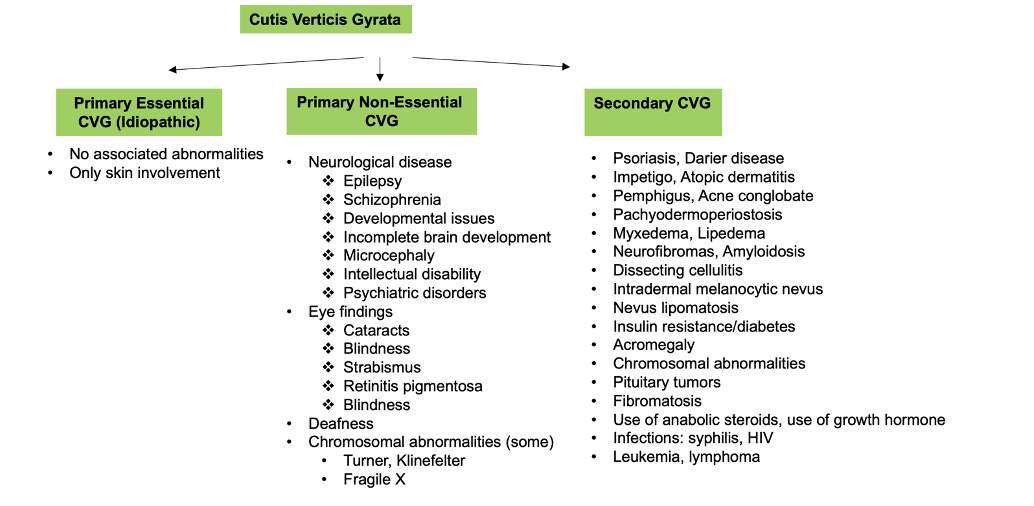"Secondary" Cutis Verticis Gyrata
Secondary CVG from Psoriasis.
Cutis verticis gyrata (CVG) is a scalp condition whereby the affected individual develops folds and furrows in the scalp that resemble the appearance of the brain’s cerebral cortex (gyri). Cutis verticis gyrata was first described in the mid 1800s. The condition is estimated to affect about 1 in 100,000 men and 1 in 400,000 women. A photo of the folds and furrows from a patient with CVG is shown below.
What is the cause of cutis verticis gyrata?
The cause of CVG often not known. Given that primary forms of CVG (see charge below) often occur after puberty, it is often thought that hormonal and endocrine issues play a role in the development of the condition.
We divide CVG into three groups according to associated conditions and potential causes. These are a) Primary essential, b) Primary non-essential and c) secondary CVG.
a) Primary Essential CVG
For many patients with CVG, there is no clear underlying cause and no abnormalities can be found. These patients are said to have “primary essential CVG.” Affected patients are usually male and develop CVG during or after puberty. The folds and ridges are usually distributed in a symmetrical manner and the vertex and the occipital region is commonly affected. Folds in primary CVG typically run in the antero-posterior direction. Patients do not have any type of underlying eye disease or neurological disease.
b) Primary Non-Essential CVG
This is the more common type of primary CVG. In primary non-essential CVG there are underlying abnormalities. These are typically neurological and ophthalmologic in nature, but hearing may sometimes be affected too. These abnormalities themselves do not actually contribute to the folds of the scalp. They are simply important associations that also need separate investigation. In other words, treatment of the neurological or eye abnormalities will not lead to changes or improvement in the furrows and grooves on the scalp. Most cases of primary CVG occur before age 30 and have a striking male predominance.
c) Secondary CVG
In so called “secondary” CVG, the patient may have one or more underlying abnormalities and these abnormalities directly contribute to the folds and furrows seen on the scalp. Unlike primary CVG, a scalp biopsy of secondary CVG often (but not always) shows features of specific underlying condition. Furthermore, treatment of the underlying condition may improve the condition of the scalp in some situations. Therefore, carefully ruling out secondary CVG is an important goal for anyone presenting with CVG.
Common underlying abnormalities in primary and secondary CVG are shown in the diagram above. We often refer to this as the classification of CVG.
Garcia-Rodriquez V et al 2023: Secondary CVG From Psoriasis.
Authors of a new study report a nice case of secondary CVG. The patient was a a 59-year-old man with a personal history of severe plaque psoriasis with scalp. He also had nail psoriasis and psoriatic arthritis. He was on biologic therapy with ustekinumab 90 mg every 12 weeks since January 2018.
The patient reported that after a recent hair cut he noticed thickening of the skin in the area of the vertex area. Examination by the clinician showed marked thickening of the skin in the form of ridges and furrows, especially in the parieto-occipital area, resembling cerebral gyri and sulci. Blood tests were fairly normal. Ultrasound and biopsy also were suggestive of CVG. In April 2019, the patient was started on ixekizumab 80 mg/4 weeks due to poor control of psoriatic arthritis. After 1 year on Ixekizumab, there was a marked improvement in psoriatic disease was seen, along with improvement of CVG. The once prominent ridges and furrows had diminished in size.
Conclusion
All in all this is a nice case of secondary CVG a reminds us that some forms of CVG respond well to treating the underlying disorder.
REFERENCE
Garcia-Rodriquez V et al. Cutis verticis gyrata secondary to scalp psoriasis. Int J Dermatol . 2023 Jun 4.
This article was written by Dr. Jeff Donovan, a Canadian and US board certified dermatologist specializing exclusively in hair loss.



